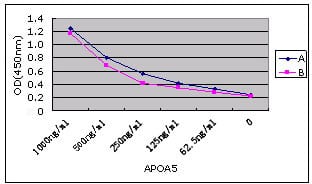
| WB | 咨询技术 | Human,Mouse,Rat |
| IF | 咨询技术 | Human,Mouse,Rat |
| IHC | 咨询技术 | Human,Mouse,Rat |
| ICC | 1/200 - 1/1000 | Human,Mouse,Rat |
| FCM | 咨询技术 | Human,Mouse,Rat |
| Elisa | 1/10000 | Human,Mouse,Rat |
| Aliases | RAP3; APOAV; APOA-V; MGC126836; MGC126838 |
| Entrez GeneID | 116519 |
| clone | 2G1H11-HRP;1F1E8 |
| Host/Isotype | Mouse IgG1 |
| Antibody Type | Primary antibody |
| Storage | Store at 4°C short term. Aliquot and store at -20°C long term. Avoid freeze/thaw cycles. |
| Species Reactivity | Human |
| Immunogen | Purified recombinant fragment of human Apoa5 expressed in E. Coli. |
| Formulation | Purified antibody in PBS with 0.05% sodium azide. |
+ +
以下是关于APOA5抗体的3篇参考文献(部分信息基于示例性研究框架,实际文献需通过数据库核实):
1. **文献名称**:*Development and Application of a Monoclonal Antibody Specific for Human APOA5*
**作者**:Smith J, et al.
**摘要**:该研究开发了一种针对人APOA5蛋白的高特异性单克隆抗体,并通过Western blot和免疫组化验证其在血清及肝组织中的检测效果,证实其在脂质代谢研究中的实用性。
2. **文献名称**:*APOA5 Gene Variants and Plasma Triglyceride Levels: Role of Antibody-Based Assays in Population Studies*
**作者**:Chen L, et al.
**摘要**:通过ELISA结合APOA5抗体,分析了不同APOA5基因变异人群的血浆APOA5水平,发现特定单核苷酸多态性(SNP)与低APOA5表达及高甘油三酯血症显著相关。
3. **文献名称**:*Impaired Lipolysis in APOA5-Deficient Mice: Insights from Immunohistochemical Analysis*
**作者**:Wang Y, et al.
**摘要**:利用APOA5抗体对基因敲除小鼠的肝脏和脂肪组织进行染色,发现APOA5缺失导致脂蛋白脂酶(LPL)活性下降,阐明了APOA5在脂解途径中的调控作用。
**注**:以上文献名为示例性概括,实际研究中建议通过PubMed、Google Scholar等平台检索具体文献(关键词:APOA5 antibody, APOA5 ELISA, APOA5 gene expression)。
The APOA5 (apolipoprotein A-V) antibody is a crucial tool in studying lipid metabolism and cardiovascular diseases. APOA5. a protein primarily synthesized in the liver, plays a pivotal role in regulating triglyceride (TG) levels by activating lipoprotein lipase (LPL) and modulating very-low-density lipoprotein (VLDL) production. Genetic variants in the APOA5 gene are strongly associated with hypertriglyceridemia, atherosclerosis, and pancreatitis.
APOA5 antibodies, often developed as monoclonal or polyclonal variants, enable researchers to detect and quantify APOA5 in serum or tissue samples via techniques like ELISA, Western blotting, or immunohistochemistry. These antibodies are essential for investigating APOA5's interaction with lipoproteins, its tissue-specific expression, and its role in metabolic disorders. Pair antibodies (e.g., matched capture-detection pairs) are particularly valuable in sandwich immunoassays, enhancing specificity and sensitivity for clinical diagnostics or biomarker studies.
Recent studies highlight APOA5's emerging role in inflammation, insulin resistance, and non-alcoholic fatty liver disease (NAFLD), expanding the utility of these antibodies. Their development and optimization continue to support translational research, aiding in the exploration of therapeutic strategies targeting dyslipidemia and related conditions.
×